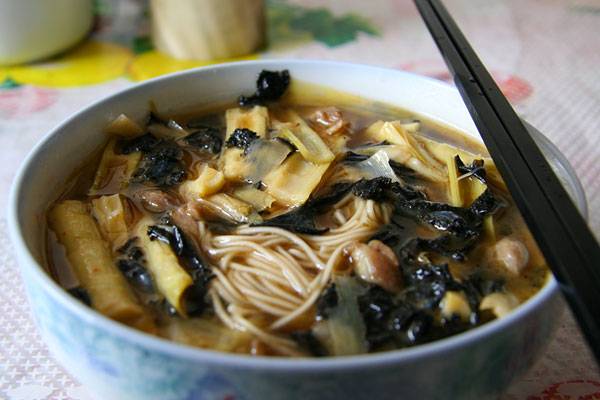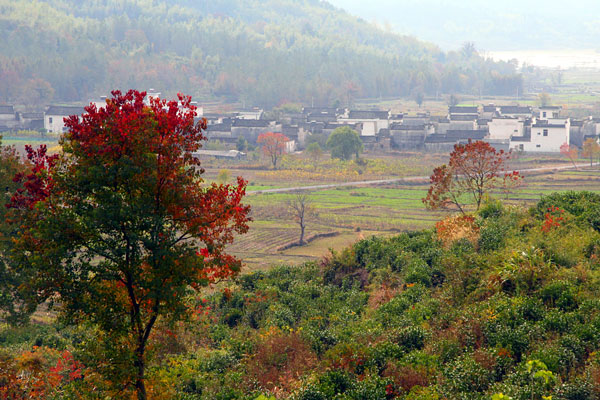
One of my wife's favorite memories of China was this day-hike at Hongcun, the UNESCO World Heritage Site where we stayed for 3 nights. It's got everything you'll want in a beginner's hike, including:
- authentic villages untouched by tourism
- diverse landscapes: bamboo groves, tea plantations, wide-open farmland and lakeshore
- easy terrain with minimal hill climbs
- cheap and easy access to the trail-head by taxi
This is probably the first ever English article about this hike (I tried but couldn't find anything on the English Internet and took the plunge ourselves). So I've produced this little map to document our route:
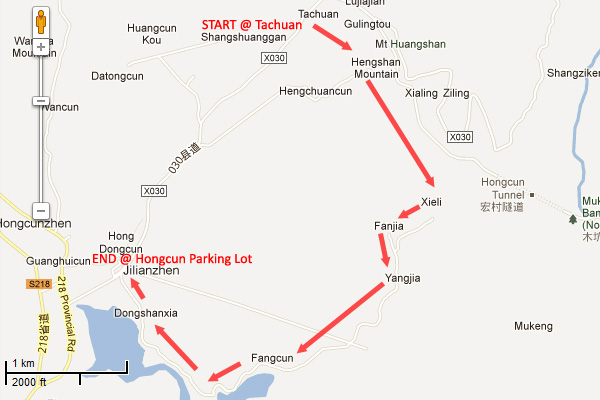
Starting point of this hike is the tiny village of Tachuan, accessible from Hongcun by taxi (RMB 20), motorcycle taxi (RMB 10), or a 40 minute hike along County Route X303 in the direction of Mukeng and eventually Huangshan Mountain. The main hike itself is about 8 km, looping back to Hongcun's Main Parking Lot at the end.
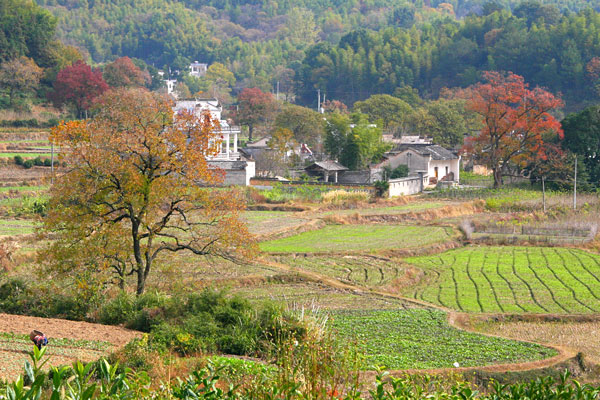
Our taxi dropped us off at a roadside viewing platform about 300m from Tachuan. This is the best spot to survey the start of the route, which will pass through Tachuan village and climb over the gentle knoll to its right, towards the village of Hengchuancun.
The village of Tachuan is actually moderately famous and is often promoted as one of China's top 3 autumn foliage sights, though I personally wouldn't rate it that high. That said, villagers may charge a nominal fee (eg. RMB 30) for entering the village during the peak viewing season of November. We were lucky to avoid it on November 7, but perhaps it was the gatekeeper's lunchtime as we arrived at 12:30. Visitors generally stay within the village though, leaving the trail to the rare hikers.
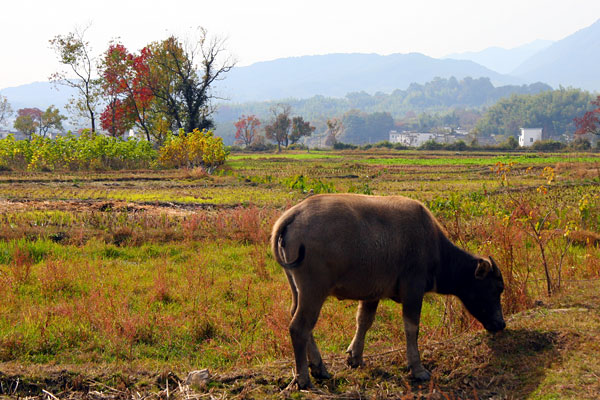
We had to immerse into village custom right from the start. As there was no trail leading from the viewing platform down to Tachuan village, we simply followed the villagers' example of walking on the narrow dividers between adjacent fields, through crops of cabbages and Yinliu flowers. Tame cattle and water buffaloes roamed these fields leisurely, enjoying their annual hiatus until next spring's planting effort.

Greeting travelers at Tachuan wasn't the picture-perfect impression imparted by world-famous Hongcun or Xidi, but the raw authenticity of villagers carrying on their daily lives on their ancestral land, oblivious to the odd outsider passing by. The locals were quite friendly though, even though they hardly understood my imperfect Mandarin Chinese and I hardly understood their Anhui dialect.
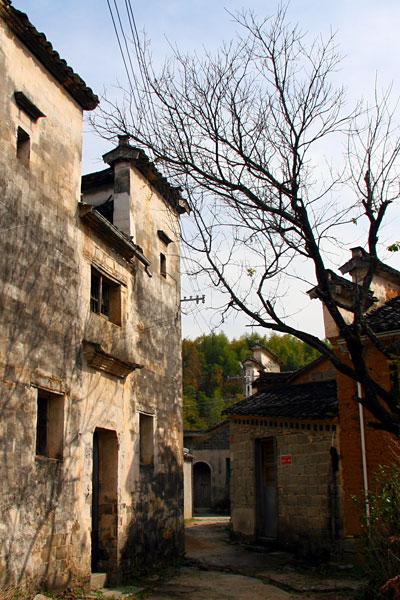
The village still boasted heritage buildings and winding lanes dating from the Qing Dynasty, and like any historic village in Southern Anhui its houses were all ornamented with towering Matouqiang firewalls, tiny claustrophobic windows and exotic rooflines.

Towards the back of the village we faced the MOST IMPORTANT CROSSROAD of the hike. The paved road in the village crossed a small concrete bridge on its way uphill, and right after the bridge there was a dirt footpath on the right side. That footpath is the correct route towards Hengchuan and Xieli, as pointed out to us by one of many kind villagers we met along the way.

The dirt path zigzagged over a densely vegetated hill overlooking Tachuan and dipped into another little hamlet on the other side. Self-standing hay bales adorned freshly harvested fields to our left and right while our trail led us straight into the village of Hengchuancun / Hengshan.

I suspect Hengchuancun is the proper name of the sprawling village along this east-west paved road leading from the main County Route X030, while Hengshan is the name of the hill at the end of the village. Our trail joined this paved road near its eastern-most end, around where the words "Hengshan Mountain" are located on the map.

The hill of Hengshan was really a large, picturesque bamboo grove dotted with little farmhouses along its sides. In fact this is only 3 km away from the famous Mukeng Bamboo Sea (Mukeng Zhuhai), arguably the most popular hike in the Hongcun area. We could have done both hikes if we had two full days of good weather, but we had only one sunny day and chose Tachuan for its wider variety of sceneries and its easier terrain on our tired thighs and knees.

One item of note: the route up Hengshan split into a footpath on the right and a paved road on the left. We took the footpath after a short discussion, only to find out later than the two paths eventually merged again. So it shouldn't matter which one you take. The footpath seemed much more direct though.

The merged trail climbed through Hengshan and traveled in a southerly direction parallel to the County Road above head. After cutting through even more bamboo groves, distant echos of traditional cymbals and Suona oboes led us into a village of cascading fields and dilapidated farmhouses. This turned out to be the village of Xieli, the one-third mark of our hike, at 1 hour 15 minutes after starting our hike.

The seemingly jovial sound of firecrackers pierced the air, and for some reason the folk melodies reminded me vaguely of loudspeaker music at traditional Chinese festivities and store openings. I asked the first villager I saw:
"Shi bu shi you hun li?," I asked. Is this a WEDDING?
"You ren guo shi le," answered a random villager. No, SOMEBODY DIED. Idiot, she didn't add.

As the procession drew closer and closer I put my camera away out of respect for the dead ... and the surviving. For the first time in my life I witnessed the ritural of a rural Chinese funeral: a male descendent covered in a coarse linen cloak and carrying the black-and-white photo of the deceased, other close relatives clad in white cloaks and white cloth headbands, younger lads bearing the load of the casket on their shoulders, other participants scattering Money of the Forthcoming Life into the wind, and the marching band of Souna musicians trailing the assembly, forcing a strangely familiar Auld Lang Syne out of these dark exotic woodwinds.
This was the China I had come for -- we diligently came for a hike, and stumbled across an authentic window into life and death in rural China. I will not soon forget this scene.
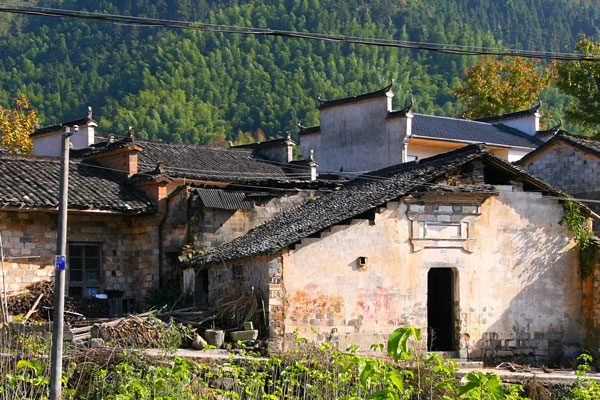
After Xieli the trail opened into a new paved road leading past a couple of little hamlets named simply after the local clans. At 1 hour 40 minutes we passed the village of Fanjia, with more dilapidated farmhouses full of character, cascading Matouqiang firewalls, and mysterious roof ornaments.
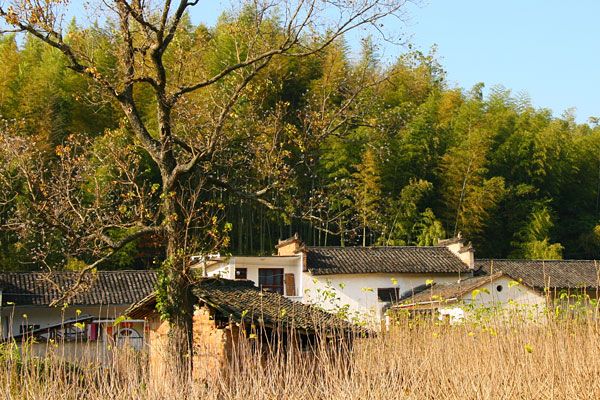
And at approximately 2 hours we reached the village of Yangjia, nested against the backdrop of more bamboo groves. Most of the locals seemed to be elderly farmers, including an old lady who offered us some locally-picked dried chrysanthemum for tea.

As we needed a brief rest stop for our weary legs, a little farmhouse appeared on the left side of the road with the hand-written signage of "Kaoqiao Store." We bought a couple bottles of soft drink and juice for RMB 3 each and sat in the store for 15 minutes while listening to the elderly owner (pictured in the foreground) calling her city-dwelling daughter-in-law and grandson. She actually looked 45 and didn't have even one speck of silver hair whatsoever, and we were aghast to learn that she was already 64.

At the two-thirds mark of our hike we reached another crossroad: the winding road ahead gracing the shore of the Qishu Reservoir en route to Hongcun, and another new road to the right leading straight to Hongcun. We took the scenic route as planned, passing more interesting scenes of rural life such as family productions of Xiangcai, the local Anhui version of pickled cabbages.

The lakeshore of Qishu Reservoir is still dotted with little farming communities and old rice terraces long predating the flooding of the once-fertile plains into the modern reservoir. Further on the horizon though, a menacing ring of hotels and residential projects have sprouted up along the southern shore, fueled by the past decade of growing middle class affluence. It's probably only a matter of time before the prime real estate of the entire lakeshore will be consumed by property developers.

On this side of the shoreline old rice terraces have been converted for a hardier and more profitable crop -- organic green tea. After all these regions surrounding the foothills of Huangshan Mountain have long been prime production areas for the famous Huangshan Maofeng, one of the so-called 10 Great Chinese Teas. 50g canisters sold for around RMB 50 inside Hongcun's souvenirs shops, though we found some for RMB 26.5 at the local supermarket.

Old fashioned horsepower is still the transportation means of choice for many local peasants, and mule carts are often seen departing Hongcun at dawn and returning at sunset. This stone quarry actually marks the final 1 km before the trail reaches Hongcun.

The last straightaway makes its final departure from the lakeshore and leads into Hongcun's Main Parking Lot. We started our hike at 12:30, and arrived back at the village at 15:50. That's quite a leisurely pace for 8 km, and if unfit office workers like us can do it in a little over 3 hours, I'm sure it can be easily done by anyone of reasonable fitness.

Now you see why my wife loved this little hike so much. The scenery was diverse and unpretentiously rustic; the locals were friendly; the Chinese funeral procession was a bonus, but most important was the number of hikers we met along the way.
ZERO!! The two of us, and nobody else, were the only hikers on the route. That's a first for us inside this country of 1.3 billion citizens.
This authenticity and tranquility, above anything else, were our favorite qualities of this easy hike. This trail is still mostly unknown to domestic Chinese tourists, let alone foreign travelers. If you're visiting Hongcun and are looking for a good hike through the Chinese countryside, this is probably one of the best trails in the area.





















